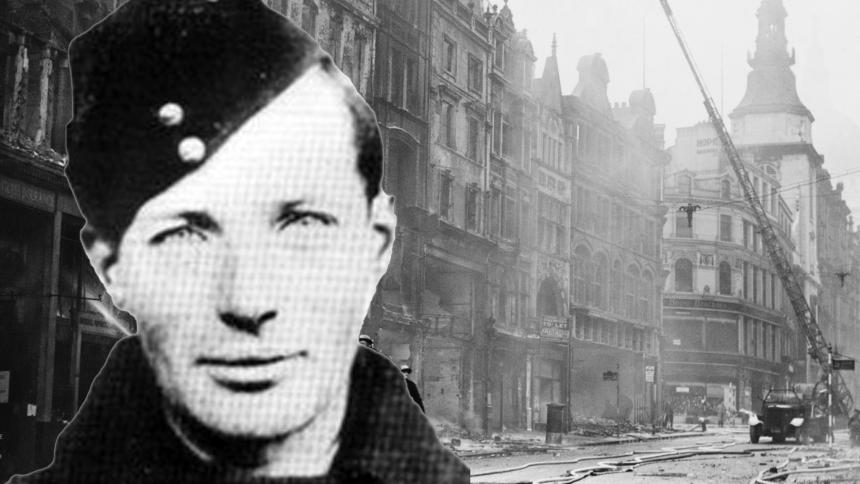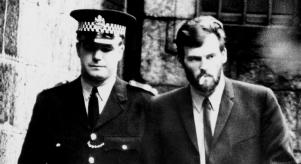
Blackout ripper: A killer in wartime London
A murderer in the midst of chaos
The dark days of the Blitz was a time when the nation did its best to pull together in the face of an enemy determined to obliterate London and other cities throughout the country. As Londoners lived in fear of the Luftwaffe raining bombs down on the capital and daily life was made tough with food rationing and a lack of basic necessities, the last thing its citizens needed was another vicious killer using its streets as a hunting ground.
Just fifty-four years after the notorious ‘Jack the Ripper’ plied his sadistic trade in carving up five women in London’s streets, another spree killer appeared in the shadows. This time the fiend, who attacked up to seven women over six days during a cold February, was eventually caught and identified as 27-year-old Gordon Frederick Cummins.
A new Jack The Ripper
During fifty-seven consecutive days of aerial bombardment the strict regulations of the blackout which all citizens had to regimentally observe, allowed the psychopathic Cummins able to carry out an orgy of obscene violence against women going about their business. Whether or not the married Cummins who had enlisted with the RAF and was serving as a LAC (Leading Aircraftman) was inspired by Britain's most infamous serial killer Jack the Ripper, his misogynistic manner of mutilation and killing shared a similar sadistic MO to the Victorian slayer of prostitutes in 1888. In less than a month during a spate of puzzling murders of mainly prostitutes, the mystery ghoul who preyed on vulnerable women at night in unlit streets was given the moniker theBlackout Ripper by the press.
First murder
On a cold Sunday morning, 8th February 1942 one Chief Superintendent Frederick Cherrill, known as ‘fingerprint man’, was called to an air raid shelter where the body of 40-year-old pharmacist Evelyn Hamilton was found face up in the gutter. Cherrill had been head of the fingerprints dept since 1938 and always insisted on visiting crime scenes himself armed with a magnifying glass. Cherrill and Detective Sydney Birch, who formed a formidable partnership together at Scotland Yard in the Fingerprint Department, both suspected at first that Hamilton was the victim of theft. She had been found by an electrician who spotted Miss Hamilton’s torch lying on the ground. Her handbag was missing £80 and she had been strangled, but there were no telltale signs of sexual interference or mutilation despite her torn clothes which revealed a naked breast. A pattern of bruises suggested the killer of Hamilton was left-handed.
Fingerprint genius
Superintendent Cherrill was, in fact, a pioneer finger and palm print expert and had already played an important part in the evolution of fingerprint forensics. Cherrill's genius was identifying single fingerprints at the scene of a crime which at the time was difficult to undertake due to lack of expertise. But by 1942 the Met's bureau of records through the efforts of Cherrill had thousands of fingerprints on file.
Unbeknownst to the investigating officers the disturbing discovery of a brutalised woman, at first suspected to be a prostitute, was to be the beginning of a psychopathic spree of violence by one man which would test police resources in a city already under fire from an avalanche of daily crime and chaos. Cummings, was stationed at the RAF ACRC (Aircraft Reception Centre in Regents Park) which was walking distance to the north London areas where his savage attacks took place. Leaving the RAF centre at the end of the day he launched his frenzied attacks under the cover of darkness.
London at the time was in the midst of mounting social pressures and a crime spike caused by austerity. From 1939 to 1945 crime rose by 50% and an undermanned police force struggled to cope with the habitual looting and racketeering in the city, as well as social problems arising from desperate and homeless citizens. In short, London was a criminal's paradise for the taking.
Frenzied attack: Second murder
Barely twenty-four hours after the grim discovery of Hamilton's strangled body a new victim of what can only be described as a frenzied assault of perversion was uncovered on Monday 9th. Discovered by two meter readers as they were let in a Soho flat, the butchered body of 35-year-old Evelyn Oatley was a horrifying sight. This time the victim was so viciously slashed that her injuries shocked the investigating officers.
A young woman with ambitions to be in showbiz, Oatley had been brutally assaulted, first by attempted strangulation before her throat was cut with a razor. The tragic irony about Oatley’s sad and brutal demise is that she had only started bedding older men out of fear of sleeping alone during the Blitz. Preferring mature men in the belief that she was less likely to encounter aggressive and violent sexual partners, she had relaxed her rule the night when she met the charming Cummins.
Sadistic mutilation
The most grotesque and evil act by Cummins on Evelyn Oatley was that while she was still alive and dying he abused her body with curling tongs before continuing mutilation with a can opener. A torch was later found to have been inserted into her vagina. This wasn't just murder on a pathological level but the act of a psychopathic maniac who despised women and derived pleasure from inflicting humiliation and pain. Leaving the can opener on display next to the body revealed a level of sadism not witnessed since the repulsive slayings of women on London's streets, almost sixty years earlier. Perhaps due to the visceral nature of Oatley's attack, which involved sexual perversion and mutilation, it was not linked by the police to that of Evelyn Hamilton’s earlier brutal murder.
Sex for sale
Oatley had possibly turned to casual prostitution to make ends meet after trying to fulfil a dream of becoming an actress in what was still a vibrant West End. Her desperate predicament, offering sexual services for money, wasn’t uncommon. Street prostitution was an open affair during the war and the exchanging of money for sex didn't become illegal until 1959.
In the hard times of a war-torn city touting for customers was far from a subtle. Prostitutes would often use torches and lighters to attract potential clients in the dark streets, devoid of any kind of illumination which suited both the street girl and the client. Sexual activity would often take place in dark doorways and alleys where the likelihood of disturbance was remote, particularly during a blackout. But it was a dangerous occupation due to both a climate of desperation, poverty and an increased number of men from the services eager perhaps to use sex as a temporary distraction from their fears and frustrations
Forensic investigation
The first step in the forensic investigation was the grim task of analysing the instruments found in Oatley’s Wardour street flat that were used on her body. Fingerprint expert Cherrill's unique skills at a time of limited forensic know-how uncovered the first clue to the killer - a single fingerprint on one of the instruments. Although no matches could be made against the Met's substantial record of prints, what Cherrill deduced was that this second murder was also carried out by a left-handed assailant.
Cherrill and Detective Sydney Birch closely working together in the same office now knew they had a fingerprint of a killer who may also be responsible for the murder of the first victim, Evelyn Hamilton. To verify this supposition they still needed a match but took a wild punt that the same man was responsible for both vicious assaults. The hunt was now on for one person.
Marylebone murder
Within twenty-four hours on Tuesday, 10th February, Cummins' next victim was discovered. Margaret Florence Lowe (also known as Pearl), nicknamed 'the Lady' due to her refinement and conservative dress sense, was said to have turned to the streets to help pay her daughter’s boarding school fees. The 43-year-old widow was to suffer an equally cruel death as a result of Cummins' unstoppable mania.
Friends and neighbours of Lowe had become concerned at her disappearance from her flat in Gosfield Street, Marylebone, which prompted a call to Chief Cherrill. The sight that was to greet him at Lowe's residence was incomprehensible in its brutality. The frenzied attack revealed the victim had been strangled with a silk stocking or scarf. As well as suffering deep cuts to her thigh, her abdomen had been ripped open, exposing her intestines and internal organs. As in the case of the second victim Evelyn Oatley, Cummins had left his tools of sadism, a knife and razor laying on the body. One interesting clue again relating to prints found on a candle that had been inserted in the victim's vagina, suggested again that a left-handed man had held the candlestick.
'Fingerprint matching' was still crude in both its knowledge and application and at the time mainly used to find matches with suspected felons going through the court process who may have committed previous crimes. It was a complex science involving over one thousand categories and permutations of finger and palm prints that had to be stored and cross-referenced to recognise points of comparison. It was only later that finger and palm print identification using a fine silver powder and brush could lift fingerprints from the scene of a crime. Unfortunately, there were no fingerprint records of Cummins on file to identify him as the killer of the three women.
Paddington murder
The tabloid press at this stage was still slow to exploit rumours that a sadistic serial killer may have been responsible for the cruel murders of three women in less than four days. But this oversight was to quickly change after Cummins’ fourth victim was found in Paddington.
On Wednesday, 11th February 1942, 32-year-old Doris Jouannet (also known as Doris Robson) was murdered in the ground-floor flat in Sussex Gardens that she shared with her husband. Described as a bored housewife, who may have turned to casual sex with strangers for fun as well as money, Jouannet had been strangled with a scarf and her naked body sexually mutilated in a similar fashion to the bodies of Oatley and Lowe.
Blackout ripper
The police, sensing that this latest murder could spark panic amongst London's citizens found their concerns exacerbated by a press who had now got wind of reports of four murders by the same man roaming the capital, came up with the moniker theBlackout Ripper.
The newspaper reports of the Blackout Ripper's obscene attacks on women created a pervading atmosphere of fear, particularly amongst the female population who had to work and commute in London alone at night. The broadsheets and the tabloids revelled in what was depicted as a latter-day Jack the Ripper, randomly striking without fear of being caught in streets that by law had to remain in pitch darkness.
But for Cummins, whether he was reading reports of his evil handiwork and noting the police stepping up their hunt for him, he was determined to carry on inflicting horror on unsuspecting female citizens.
Botched attacks
The 12th of February passed without incident but the next day on Friday the 13th Cummins struck again. This time the ominous date associated with bad omens turned out to be a lucky escape for 32-year-old Mary (also known as Greta) Haywood. Cummins approached Haywood in a Piccadilly restaurant and despite her rejecting his offer of money for sex (£30) Haywood still accompanied the killer into the dark streets. Once away from the crowds the superficially charming deviant grabbed Haywood, pushed her into a dark doorway and tried to put his hand inside her skirt. As Haywood resisted and tried to fight him off, she fell unconscious. Just as Cummins was about to carry out another repulsive act of savagery a torchlight, held by an 18-year-old night porter, shone into the doorway and prompted Cummins to run away.
His bloodlust unsated, Cummins continued to prowl the streets looking for victims when he happened across streetwise prostitute Catherine Mulcahy near Paddington Station. At first, Cummins appeared personable and respectful, offering Mulcahy £5 for her services back at her flat. On entering Mulcahy’s home she wisely kept her boots on as Cummins soon reverted to type and tried to strangle her. The quick-thinking Mulcahy kicked him hard in the shins prompting Cummins to stop and bizarrely give her another five-pound note before running away. But in his hurry, the maniac left behind a second clue in the form of his belt.
Clues
The first clue, not at the time acknowledged with any great significance, was left behind during the unsuccessful attack on Mary Haywood in Piccadilly. Due to the interruption of the teenage night porter, Cummins had made a crucial error in leaving his service respirator behind which bore the serial number 525987. Concerned by the press reports of a killer at large the porter delivered the respirator and the attack victim to the police station at Savile Row. Even though the police were of the mind that the attack on Haywood could have just been a case of common assault or attempted rape, rather than being connected to the Blackout Ripper, they had the foresight to contact the RAF to trace the owner of the respirator.
Cummins only defence was to try and discredit fingerprint expert Cherrill’s testimony during the highly emotive trial, where Cummins arrogantly appeared as his own defence during the second day. He continually stressed his complete innocence of the murders and raised the possibility that any RAF cadet could have taken out his gas mask from the Aircraft Reception Centre. But fingerprint evidence found at second victim Oatley's flat and also inside the retrieved gas mask, along with debris found in the respirator that came from the bomb site shelter of the first victim Evelyn Hamilton, all went to make the case against Cummins stronger. It took the jury just thirty-five minutes to deliver a verdict of guilty. Gordon Cummins was sentenced to death and despite a campaign by his shocked and distressed family, including the Archbishop of Canterbury, to reprieve the death sentence, the Blackout Ripper, who had slain four women in the most vicious, obscene and sadistic manner was finally hung on the 25th June, 1942.
Arrest and trial
When Cummins returned to the RAF Reception Centre in Regents Park centre in the early hours of the morning he was greeted by the police who took him to West End Central police station to be questioned about his whereabouts and the attack on Mary Haywood. Charged with common assault the police continued with their investigation of Cummins and discovered in his quarters several incriminating articles, including an initialised pen and cigarette case and a comb belonging to two of his victims. On the 17th February, the day before Cummins 28th birthday the sadistic killer who had wrought such terror amongst London’s streets in less than seven days appeared at Bow Street police court to be charged with all four murders and attacks. When he was fingerprinted by Detective Cherrill, the fingerprint expert noted Cummins signed his name with his left hand.
Still declaring his innocence Cummins appeared at the Old Bailey on the 23rd April, 1942. The trial was initially interrupted and abandoned after the wrong exhibit was presented resulting in courtroom proceedings having to commence with a new trial and a new jury a week later.
Execution and campaign
Cummins only defence was to try and discredit fingerprint expert Cherrill’s testimony during the highly emotive trial, where Cummins arrogantly appeared as his own defence during the second day. He continually stressed his complete innocence of the murders and raised the possibility that any RAF cadet could have taken out his gas mask from the Aircraft Reception Centre. But fingerprint evidence found at second victim Oatley's flat and also inside the retrieved gas mask, along with debris found in the respirator that came from the bomb site shelter of the first victim Evelyn Hamilton, all went to make the case against Cummins stronger. It took the jury just thirty-five minutes to deliver a verdict of guilty. Gordon Cummins was sentenced to death and despite a campaign by his shocked and distressed family, including the Archbishop of Canterbury, to reprieve the death sentence, the Blackout Ripper, who had slain four women in the most vicious, obscene and sadistic manner was finally hung on the 25th June, 1942.





